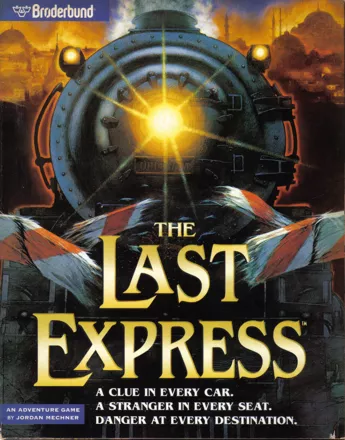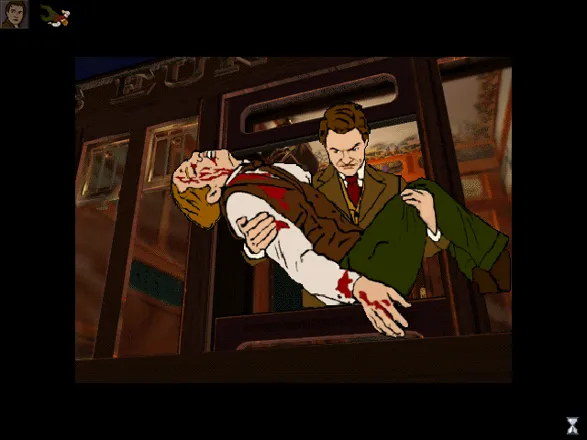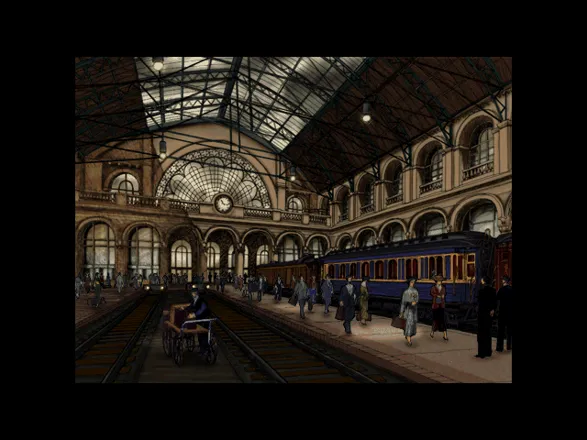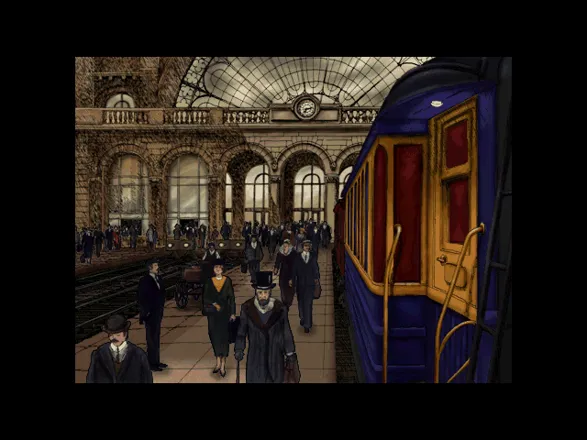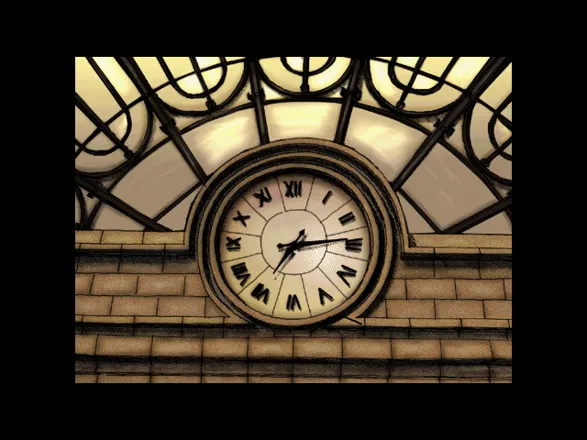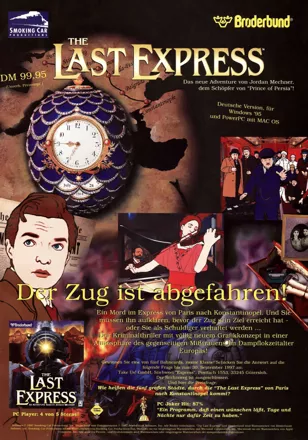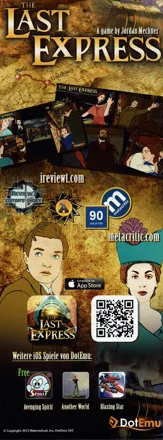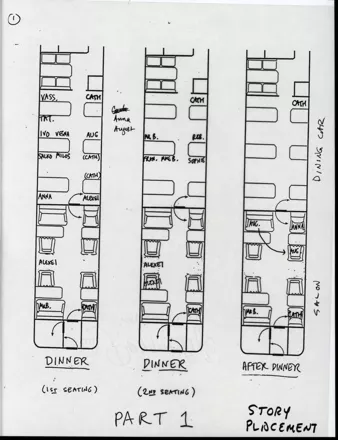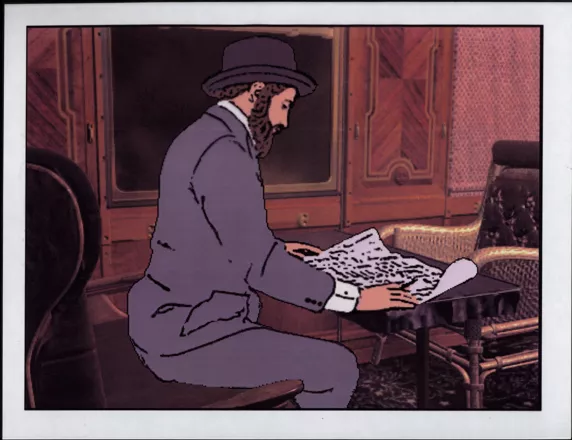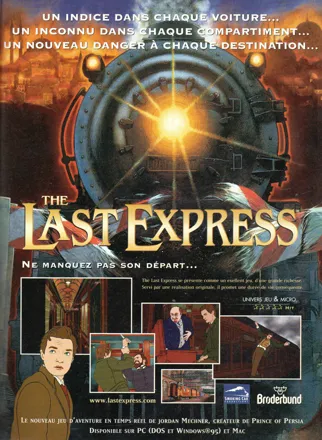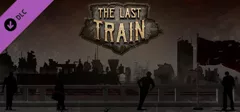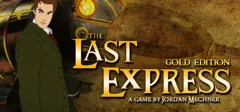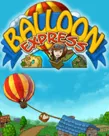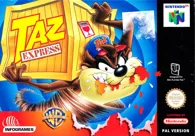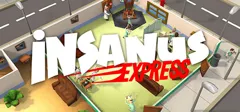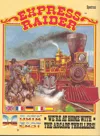The Last Express
Description official descriptions
The Orient Express is about to depart from Paris to Constantinople. As the train slowly begins to move away from the station, a young, courageously looking man jumps on it from his motorcycle and makes his way inside. This man is an American doctor named Robert Cath, escaping from authorities as a suspect in the murder of a policeman. In the train, he finds the dead body of the person he was supposed to meet. Now he has to act quickly. The only way not to arise the suspicions of the police is to disguise himself as the murdered man. A very dangerous investigation begins, and the hero soon finds himself involved in a deep net of personal intrigues and political conspiracies.
The Last Express is a real-time adventure game set in 1914, shortly before the outbreak of the World War, in a concrete historical and geographical environment. The game uses a simple point-and-click interface for interacting with people and objects, and navigating the character from a first-person perspective through pre-rendered backgrounds. From the moment the player gains control of Robert Cath, time begins to flow. If the player fails to solve a part of the mystery until the train arrives at the next station, certain events the player was supposed to prevent will occur, ending the game prematurely. It is impossible to permanently die in the game, as the player has the ability to rewind the clock in order to replay a specific period of time.
The player is for the most part free to explore the train, and the story progression has a certain degree of non-linearity. Characters follow their own schedules, frequently moving between locations, talking to each other, and generally acting independently of the player's input. The player can decide to interrupt conversations, remain unnoticed, or openly follow characters and witness their activities. For example, at a certain moment in the game's timeline two characters will perform a classical sonata for violin and piano; the player can opt for staying and listening to the performance, or use the time to explore other locations. Along with detective work and a few inventory-based and logical puzzles, the player's main task in the game is to eavesdrop on people's conversations, talk to characters, and solve the mystery by finding out more information about the bizarre case. There are also several timing-oriented fighting sequences in the game.
The game's visuals resemble "art nouveau" style that was prominent in the historical time period described in it. The similarity to the style is achieved by using rotoscoping technique. Actors wearing distinctive make-up and costumes were filmed against a bluescreen, digitized, turned into black-and-white frames and colored by hand. The game is also notable for including authentic dialogue recorded by native speakers of several languages (French, German, Russian and others), with English subtitles displayed.
Groups +
Screenshots
Promos
Credits (DOS version)
353 People (280 developers, 73 thanks) · View all
| Game Designer/Director | |
| Written By | |
| Technical Director/Director of Software Development | |
| Art Director | |
| 3D Art Director | |
| Producer | |
| Programming and Technical Design (Lead) | |
| Programming and Technical Design | |
| Executive Producers | |
| Assistant Art Director | |
| Technical Production Supervisor | |
| Background Illustrations | |
| Rotoscope Designer | |
| Supervising Sound Editor/Mixer | |
| Music Composed By | |
| Principal 3D Artist | |
| Windows Programming | |
| Macintosh Programming | |
| Additional Programming | |
| NIS Manager | |
| [ full credits ] | |
Reviews
Critics
Average score: 82% (based on 33 ratings)
Players
Average score: 4.0 out of 5 (based on 127 ratings with 9 reviews)
The Good
The atmosphere is second to none. The storyline is deep, tense and interesting. The voice acting is superb - best I've ever heard.
The Bad
Some of the fight sequences are a little unintuitive. The stop-motion animation might put some folks off. Sometimes the time drags as you wait for events to unfold.
The Bottom Line
This game had a hard time being widely accepted, as it came out at a time when the gaming industry was hyping cutting edge graphics, and more thoughtful (but less graphically exciting) games like this were basically ignored.
This is a beautifully crafted game that takes the player back in time to an earlier era. The story takes place in the last days before the Great War changed the face of Europe forever. You are a rogue American adventurer named Robert Cath, and all the action takes place aboard the Orient Express on its final trip from Paris to Constantinople (modern day Istanbul).
Players will first notice that the game uses a sort of stop-motion comic-book style of animation. This is the game's only serious hurdle. Some folks dislike it, others don't mind it at all. I thought it added to the game, as the Art Nouveau style of the graphics lent the requisite old-fashioned air to a game set in Europe in the early years of the 20th Century. Had it been made using a more modern style, I feel it would have lost something. As it is, the visual choice that the developers made seems perfect for the period and serve to draw you deeper into the story.
Another choice the developers made was to make all the game action take place in real time. Again, this choice may be disliked by players who want fast-paced excitement all the time. At certain periods you have time to just drink in the atmosphere of Europe on the brink of war. This is part of the game's allure. It's a game for people who like to change into a robe on a winter's evening, set a roaring fire in the fireplace and curl up in an overstuffed armchair with a well-written historical novel.
The game presents players with a traditional adventure story, and a rich and deeply involving one at that. The action starts in a Paris train station, and you are soon aboard the Orient Express. As you board the train you have no idea what the next 48 hours will bring, but you will be called on to perform deeds that will determine the very future of Europe. As the story unfolds, you are torn between your allegiance to yourself and your responsibility to save Europe as it plunges into chaos. You will experience adventure, the temptation of riches, love, and tragedy as the Orient Express takes you inexorably towards your destiny.
This game is probably the best game I have ever played. I have owned it for 8 years and I think I've had it on my hard drive all of that time. In terms of atmosphere and story it is unmatched. I am not ashamed to say that it is the only game I've ever played that has made me weep for the characters. Emotionally engaging, deep and ultimately unforgettable, for me this is the perfect game.
If what I've written above appeals to you, you will love this game. Although it was written for Windows 95 it plays perfectly on modern Windows XP systems.
Windows · by Ian Cooper (3) · 2006
The Good
What I really like about this game is the fact that I feel that I AM a character. Unlike any other game I can think of, the character actually means something and interacts perfectly with other characters. And it's not like other games where time doesn't pass by unless you do something. No, just like in real life, time passes by regardless of whether you do anything or not, and characters just interact with each other. It just feels too real, and the characters are really deep and each has its own story. The train is beautifully remade, and you can just chill out, do nothing, go talk to people, overhear their conversations, listen to a concert by its passengers, steal things, read people's diaries... and most importantly find out who killed your friend who was on the train before you jumped in. 100/100
Job perfectly done.
The Bad
The animations might be a little primitive, but considering the year the game was made they're excellent, and after a while, you'll get used to them.
The Bottom Line
JUST BUY THIS GAME!
Windows · by Fares Najem (3) · 2004
I thougt the game is great and have played it twice so far.Four stars from me.
The Good
The characters appear to be real actors made to look more atificial. This is an older game so the graphics are not like todays graphics. I enjoyed the change and went back in time with it. The game has many things happening all the time and some at the same time. You don't have to save game. It is controled by a running clock that you can rewind to replay a certain part. You seldon see yourself unless you are personally interacting with another passenger. If you are captured or killed the game automatically rewinds to just before that time. This allows you to make a different decision. Certain things have to be done for completion of each section but there is no specific time to do them in each time period. You can change the sequence of the way in which you interact with the characters. Sometimes this will change the way they treat you. If you don't like the way things are going, rewind the clock a little at a time to place yourself back to where a certain event happened and try another method.
The Bad
There are a few parts where the main character has to fight and I'm not good at that. I did manage to get though after many trys.
The Bottom Line
I would highly recomend it. It has a true historical background. The train, itself, is modeled from a real train of that time period. It is exciting and very well done. You can learn from your mistakes and change at any time.
DOS · by Barbara DiNatale (8) · 2000
Discussion
| Subject | By | Date |
|---|---|---|
| Hopelessly stuck... | vedder (75617) | Apr 28, 2011 |
| Paul Verhoeven! | Depeche Mike (17454) | Apr 15, 2010 |
| Revisiting An Unsung Classic | St. Martyne (3648) | Nov 29, 2008 |
| Why couldn't there be more games like this? | Unicorn Lynx (181607) | May 21, 2007 |
Trivia
1001 Video Games
The PC version of The Last Express appears in the book 1001 Video Games You Must Play Before You Die by General Editor Tony Mott.
Cameo
Designer Jordan Mechner makes a cameo appearance, as one of the porters loading August Schmidt's merchandise crate onto the train at the Munich station.
Inspiration
In Marc A. Saltzman's Game Design: Secrets of the Sages (BradyGames 1999), Mechner points out several sources of inspiration for The Last Express: * The Alfred Hitchcock movie The Lady Vanishes (1938) provided the idea to use a train as the setting * The plot was modeled after spy novels such as John Buchan’s The 39 Steps and stories by John Le Carré * European comic artists François Schuiten and Enki Bilal inspired Mechner to use stylized drawings instead of real-life actors * Characters were drawn in the style of the Art Nouveau period * The game is set during World War I because “the Second World War as a scenario is overstressed, in games as well as in movies”
Music
The soundtrack of the game is available on audio CD. Its composer, Elia Cmiral says the following about the score:
The Last Express was my first composition for a computer game, as well as my first serious assignment after moving to Los Angeles. It was a large project that took three months to complete. Before I could begin, however, I had to learn the requirements of writing for this new medium, and plan how to write such a large number of short cues. Director Jordan Mechner was a great help and a good teacher to help me navigate both the game and the new genre. The story has many unique characters of different ethnicities, exotic environments and a wide range of moods including suspense, drama and love. I developed groups of cues and assigned them themes or orchestral colors. Each group expresses a certain feeling and is tied thematically to the others in the group. This reduced the number of themes and kept me focused on the characters’ emotions. The main theme evokes a touch of sadness, romanticism, and tension on the eve of the First World War. The score relies on a small ensemble of strings with violin solo, some hand percussion, and extensive use of synthesizers for color and texture.
The music Anna and Kronos play at the concert in Kronos' private car is Sonata for Violin and Piano by C. Franck, a Belgian/French composer of the end of the 19th century. It is one of the most famous violin sonatas of all times. It can be heard any time the player goes to Kronos' car.
Orient Express
Developer Smoking Car Productions went to great pains to digitally replicate the Orient Express accurately. When they tried to find an authentic train car from the period before World War I, they soon learned that there were two versions: Teakwood wagons that were in service just up to 1914, and the steel cars that replaced them since. Unfortunately, few of the fragile wooden cars had survived World War I, even less the chaos of WW II.
Through a network of train buffs, however, the production team was able to track down a sleeping car. A man in France gave the team the name of a man in Italy who knew of a car in Athens, Greece. It had lain there abandoned for some 50 years.
Lead 3D artist Donald Grahame and his crew took hundreds of photos of the car and complemented them with contemporary pictures. The design staff also rummaged through archives and dug out original blueprints, train schedules and logbooks, read pre-war newspapers and magazines, traveled and dined in trains, and watched any Orient Express movie they could lay their hands on – all this to ensure that they would be able to recreate the Orient Express and the atmosphere on board in detail.
Languages
Most characters in the game talk to each other in their native tongues, but strangely enough, the native German speakers Anna and Schmidt rarely use German when talking to each other. Also, unlike in most movies, the Russians (as well as the French and the Germans) of The Last Express are absolutely authentic. All the Russian characters speak Russian without a trace of an accent.
Sales
The project took nearly four years to complete and included a month-long blue-screen filmshoot and a round-the-clock staff of up to 50 animators, artists, asset wranglers, and programmers. The game only remained in stores for a few months. Broderbund's marketing department quit just weeks before the game was released, resulting in virtually no advertising for it. Softbank pulled out of the game market, dissolving its subsidiary GameBank and canceling several dozen titles in development, including the nearly finished PlayStation port of the game. The Last Express was out of print long before its first Christmas season and nearly a million units shy of breaking even. By dropping their support of an already completed game, Broderbund and Softbank most likely increased their losses.
Style
All the game’s characters are drawn in Art Nouveau style. Art Nouveau (French for "New Art") was a major movement in European arts, starting in the 1880s and declining with the beginning of the First World War in 1914, the time The Last Express is set in. Artists of all kinds (writers, sculptors, painters like Henri de Toulouse-Lautrec in France, architects like Gaudi in Spain) aimed for a unification of all arts and for an erasure of stylistic boundaries. Art Nouveau paintings are naturalistic, yet minimalist through the use of clear lines, strong colors and little to no shading. To modern eyes, this makes them sometimes look like cartoon drawings. The Last Express mimics this style.
Despite their ink-paint look, the passengers of The Last Express were not hand-drawn, but played by real-life actors. Smoking Car artists processed the blue-screen footage of the characters into thousands of black-and-white stills, which were then recolored in Art Nouveau fashion, rotoscoped (i.e. cut out) and finally projected into the 3D-rendered Orient Express backgrounds. To increase the cartoon look, the actors had to have distinctive features such as beards and hats and wore special costumes with marked lines and strong colors. Make-up artist also tortured them with colored streaks in the hair and a homogeneous facial make-up. Take a look at the behind-the-scenes movie here.
Awards
- Buyers Guide
- 1998 - Best Adventure and Role-Playing Game
- Computer Games Magazine
- One of the Top 10 Graphic Adventure Games of the 1990s
- Family PC Top Rated Awards
- 1997 - Best Adventure Game
- Macworld Game Hall of Fame
- 1998 - Best Role Playing Game
- Washington Post
- Golden Fez Award
Information also contributed by -Chris, CaptainCanuck, Isdaron, Unicorn Lynx and Ye Olde Infocomme Shoppe.
Analytics
Related Sites +
-
Crap Shoot
A humorous review on PC Gamer -
FAQ for The Last Express
A thorough FAQ, including all possible endings plus detailed discussion of plot. -
Hints for The Last Express
These hints will get you through the game without spoiling the game. Authored by Robert Norton. -
Jordan Mechner's The Last Express
Dedicated section on game author's site (official site), with comments on the game making experience and the exclusive patented animation technique, and more. -
The Last Express Review
A review of the Macintosh version of Brøderbund's pre-war adventure game, The Last Express, by Marc Khadpe (Sept. 12, 1998). -
Zarf's Review
A Mac review of The Last Express by Andrew Plotkin (January, 1999). -
interview (November 28, 2008)
for Gamasutra with Mark Netter and Mark Moran
Identifiers +
Contribute
Are you familiar with this game? Help document and preserve this entry in video game history! If your contribution is approved, you will earn points and be credited as a contributor.
Contributors to this Entry
Game added by Shane k.
Blacknut added by Sciere. Android added by Kabushi. Macintosh added by Martin Smith. iPad, iPhone added by Isdaron.
Additional contributors: Eurythmic, Unicorn Lynx, Jeanne, Zeppin, Dennis Ploeger, Cantillon, Patrick Bregger, FatherJack, click here to win an iPhone9SSSS.
Game added March 27, 2000. Last modified March 2, 2025.


